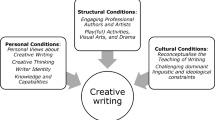Abstract
Combining children's natural storytelling abilities with quality multicultural literature serves to enhance their language skills and students' appreciation of cultural differences. Narrative abilities—particularly stories—are a natural vehicle for building on children's oral language skills and develop literacy with print. If the stories have a multicultural focus, it is only natural that readers and participants will develop an appreciation of both cultural similarities and differences.
Similar content being viewed by others
REFERENCES
Anderson, N. A. (2002). Elementary children's literature: The basics for teachers and parents. Boston: Allyn & Bacon.
Barry, A. (1990). Teaching reading in a multicultural framework. Reading Horizons, 31(1), 39–48.
Chenfield, M. B. (2002). Once upon a time. The end! Language Arts, 79(4), 332–36.
Csak, N. L. B. (2002). What's important when you're six?—Valuing children's oral stories. Language Arts, 79(6), 488–497.
Cox, S., & Galda, L. (1990). Multicultural literature: Mirrors and windows on a global community. The Reading Teacher, 43(8), 582–589.
Dyson, A. H. (1994). “I'm gonna express myself” The politics of story in the children's worlds. In A. H. Dyson & C. Genishi (Eds.), The need for story(pp. 155–171). Urbana, IL: National Council of Teachers of English.
Hamilton, V. (1987). The known, the remembered and the Imagined: Celebrating Afro-American folktales. Children's Literature in Education, 18(2), 67–75.
Heath, S. B. (1994). Stories as ways of acting together. In A. H. Dyson & C. Genishi (Eds.), The need for story(pp. 206–220). Urbana, IL: National Council of Teachers of English.
Jalongo, M. R. (1991). The role of the teacher in the 21st century: An insider's view. Bloomington, IN: National Education Service.
Jalongo, M. R. (2003). Early childhood language arts(3rd ed.). Boston: Allyn & Bacon.
Katz, L. G., & Chard, S. (2000). Engaging children's minds: The project approach, (2nd ed.). Norwood, NJ: Ablex.
MacDonald, M. R. (1993). The storyteller's start-up book: Finding, learning, performing, and using folk tales, including twelve tell able tales. New York: August House.
Mathis, J. B. (2001). Respond to stories with stories: Teachers discuss multicultural children's literature. The Social Studies, 92(4), 155–160.
Nelson, O. (1989). Storytelling: Language experience for meaning making. The Reading Teacher, 42(6), 386–390.
Perini, R. L. (2002). The pearl in the shell: Author's notes in multicultural children's literature. The Reading Teacher, 55(5), 428–431.
Patton, J. (1984). Understanding of cultures linked to better education. The Patriot, 29 Nov.
Roney, R. Craig. (1989). Back to the basics with storytelling. The Reading Teacher, 42(7), 520–523.
Rushton, S. P. (2001). Applying brain research to create developmentally appropriate learning environments. Young Children, 56(5), 76–82.
Rushton, S., & Larkin, E. (2001). Shaping the learning environment: Connecting developmentally appropriate practices to brain research. Early Childhood Education Journal, 29(1), 25–34.
Smith, F. (1990). To think. New York: Teachers College Press.
Sleeter, C. E., & Grant, C. A. (2002). Making choices for multicultural education: Five approaches to race, class, and gender(4th ed.). Upper Saddle River, NJ: Prentice-Hall.
Valdez, A. (1999). Learning in living color. Boston: Allyn & Bacon.
Author information
Authors and Affiliations
Corresponding author
Rights and permissions
About this article
Cite this article
St. Amour, M.J. Connecting Children's Stories to Children's Literature: Meeting Diversity Needs. Early Childhood Education Journal 31, 47–51 (2003). https://doi.org/10.1023/A:1025136802668
Issue Date:
DOI: https://doi.org/10.1023/A:1025136802668




